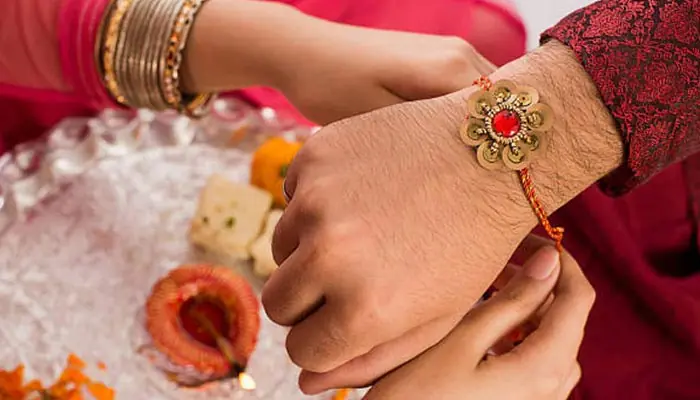
Raksha Bandhan, one of India’s most cherished festivals, beautifully encapsulates the special bond shared between brothers and sisters. Celebrated across regions, languages, and cultures, this festival transcends mere ritual—it embodies love, trust, protection, and the timeless unity of family. With roots stretching deep into India’s ancient past, Raksha Bandhan remains a vibrant and essential part of the cultural tapestry, adapting gracefully to modern times while retaining its core values.
The Meaning and Etymology
The name “Raksha Bandhan” comes from Sanskrit, where “Raksha” means protection and “Bandhan” means bond or tie. Literally, it translates to “the bond of protection.” The essence of this festival lies in the promise exchanged—a sister ties a sacred thread (rakhi) on her brother’s wrist, and in return, the brother vows to protect her throughout his life. This sacred act is symbolic, representing mutual care and responsibility.
Mythological and Historical Origins
Raksha Bandhan boasts a multitude of origins, steeped in mythology and history:
- Draupadi and Krishna: One popular legend links Raksha Bandhan to the Mahabharata. After Lord Krishna injured his finger, Draupadi, the wife of the Pandavas, tore a strip from her sari and tied it around his wound. Touched by her gesture, Krishna vowed to protect her perpetually.
- Yamuna and Yama: Another legend involves the goddess Yamuna and her brother Yama, the god of death. Moved by her affection, Yama declared that any brother whose sister ties a rakhi would be blessed with longevity.
- Emperor Humayun and Queen Karnavati: In medieval India, Queen Karnavati of Chittor sent a rakhi to Mughal Emperor Humayun, asking for protection from Bahadur Shah. Humayun honored the bond and rushed to her aid, though he arrived too late to prevent tragedy. The gesture, however, underscored the sanctity of the rakhi.
These stories highlight that Raksha Bandhan is not confined solely to biological siblings but can also symbolize the protective bond between any two people.
The Rituals and Celebrations
Raksha Bandhan usually falls on the full moon day (Purnima) of the Hindu month of Shravan (July-August). The day begins with bath and prayers, as families prepare for the ceremony. Sisters prepare decorative plates (thalis) with rakhis, sweets, rice, turmeric, and a diya (lamp).
- The Tying of the Rakhi: The sister ties the rakhi around her brother’s right wrist, applies a tilak (vermilion mark) on his forehead, and performs aarti (prayer ritual).
- Exchange of Sweets and Gifts: Brothers in turn offer gifts—ranging from money, clothes, jewelry, or thoughtful tokens—and promise protection and support.
- Family Gathering: The ritual is followed by communal feasts, laughter, and sharing of stories, making it a day of strengthening familial ties.
For siblings separated by distance, rakhis and gifts are sent by post or courier, and in recent years, digital rakhis and e-commerce platforms have brought the ritual into the virtual space.
Regional Variations and Modern Adaptations
Raksha Bandhan is celebrated in different ways across India, reinforcing the country’s linguistic and cultural diversity. In Maharashtra, it’s associated with Narali Purnima—a day fishermen offer prayers to the sea. In Punjab, it coincides with the festival of Saluno; in South India, it is observed as Avani Avittam, when Brahmin men change their sacred thread.
In recent years, the festival has transcended religious and geographic barriers. Rakhi has become a secular thread, tied among friends, neighbors, and even between soldiers and civilians. Many schools and organizations promote the tying of rakhis as a message of unity and brotherhood beyond the family.
Symbolism and Contemporary Relevance
At its core, Raksha Bandhan stands as a metaphor for mutual respect, duty, and social harmony. In a world often fragmented by self-interest, the simplicity and earnestness of the ritual—promising to care for one another—hold immense relevance. In modern households where gender roles are being redefined, sisters too pledge to protect their brothers, emphasizing that care knows no gender constraints.
Some organizations use Raksha Bandhan as an occasion to promote social causes: environmentalists, for instance, tie rakhis to trees symbolizing a promise of ecological protection; police and armed forces are often honored with rakhis as gratitude for their service.
The Commerce and Creativity of Rakhi
Rakhi itself has evolved beyond a plain thread. Markets flood with ornate rakhis—embellished with beads, gemstones, cartoon characters, and even personalized messages. Handmade rakhis, designer pieces, and eco-friendly versions offer something for every aesthetic. This commercial aspect, while sometimes critiqued for consumerism, also reveals the creativity and adaptability that keeps the festival alive in every era.
Hindi Film and Literary Influence
Bollywood has long celebrated Raksha Bandhan in iconic scenes, often evoking emotional narratives of sacrifice, loyalty, and sibling love. Rakhi songs and stories resonate deeply with audiences, further cementing the festival in the cultural consciousness.
The Enduring Spirit of Raksha Bandhan
Raksha Bandhan’s enduring appeal lies in its universality—its central message of love and protection transcends cultural, religious, and geographic boundaries. Whether performed in the sacred confines of a family home, on a busy city street, or through a digital screen, tying a rakhi is a gentle assertion that, amidst life’s uncertainties, there are ties that bind, watch over, and inspire us.
As India grows more urbanized and globalized, Raksha Bandhan remains a cherished reminder that traditions endure not because they resist change, but because they adapt, absorb, and inspire new meanings for every generation. In celebrating Raksha Bandhan, families reaffirm their faith in one another, in the promise of protection and care—and, ultimately, in the unbreakable spirit of togetherness.
